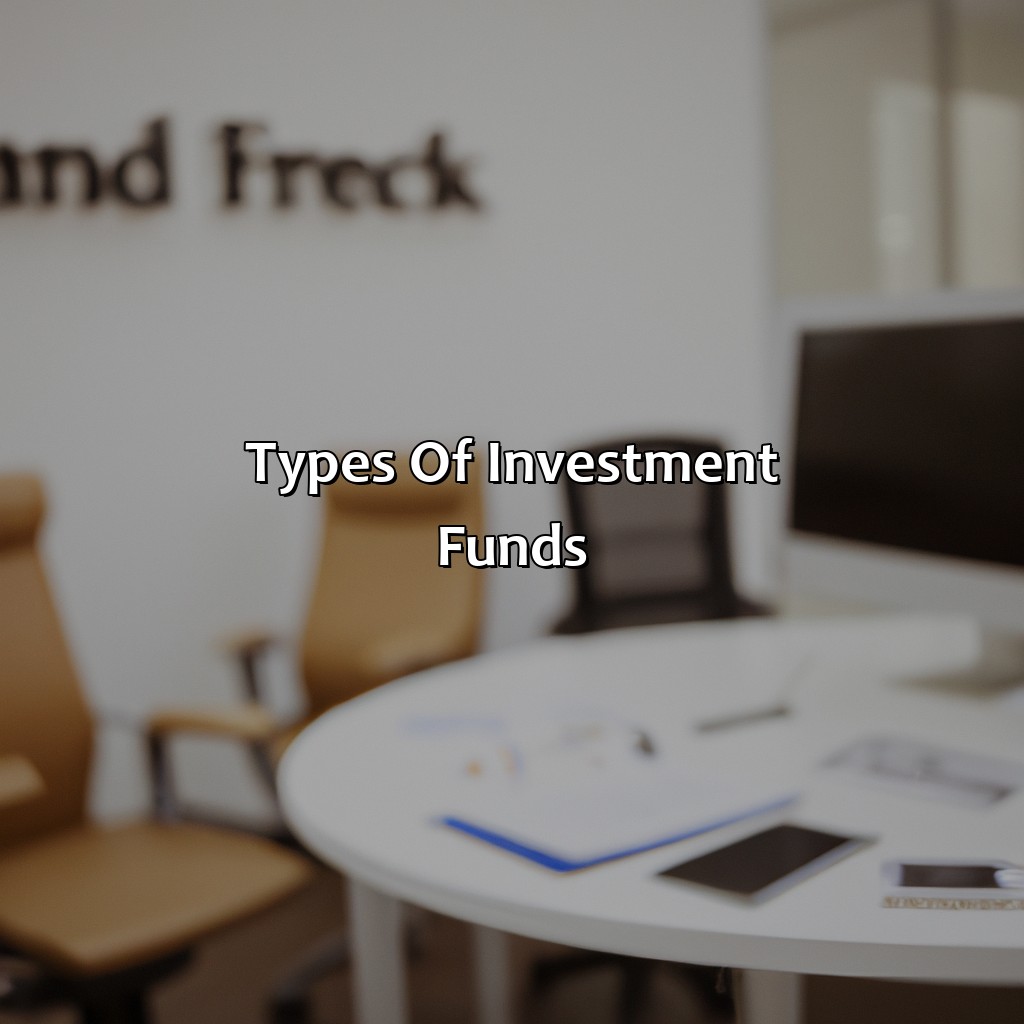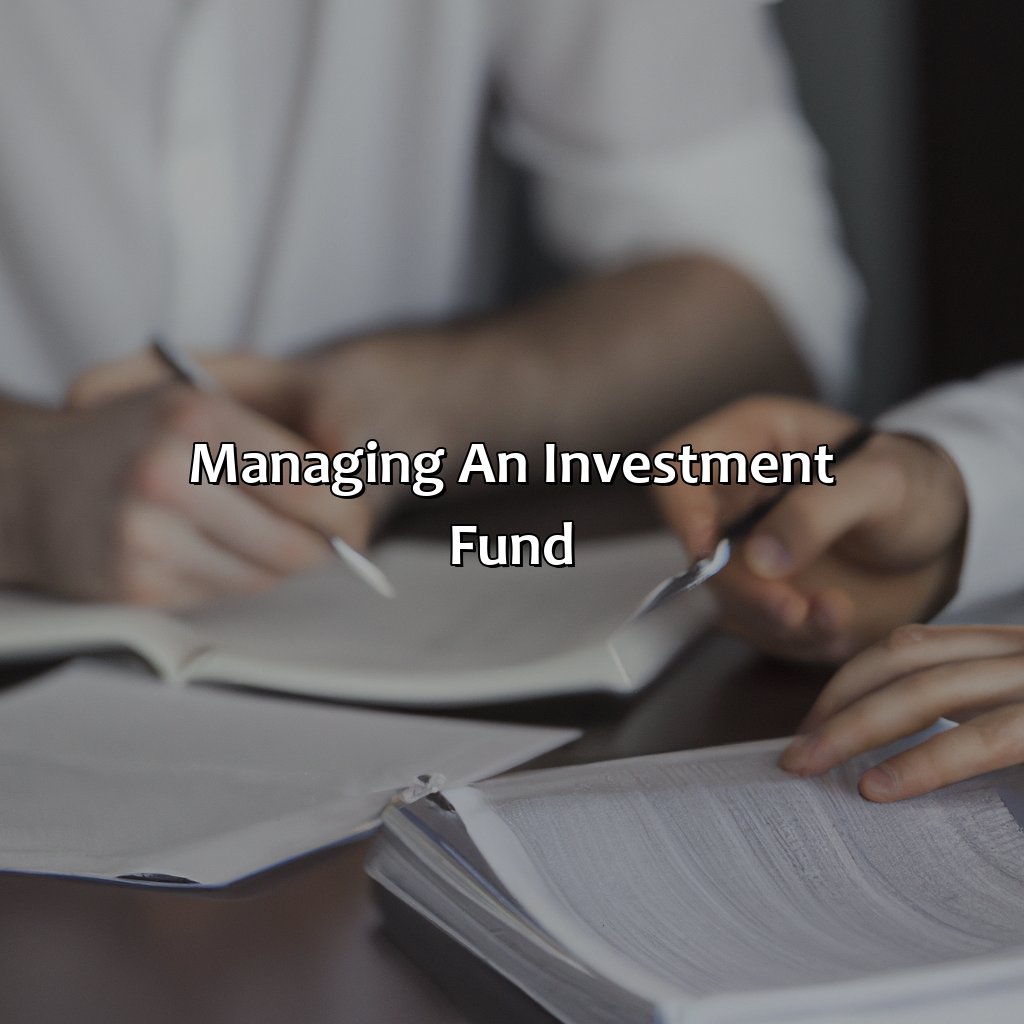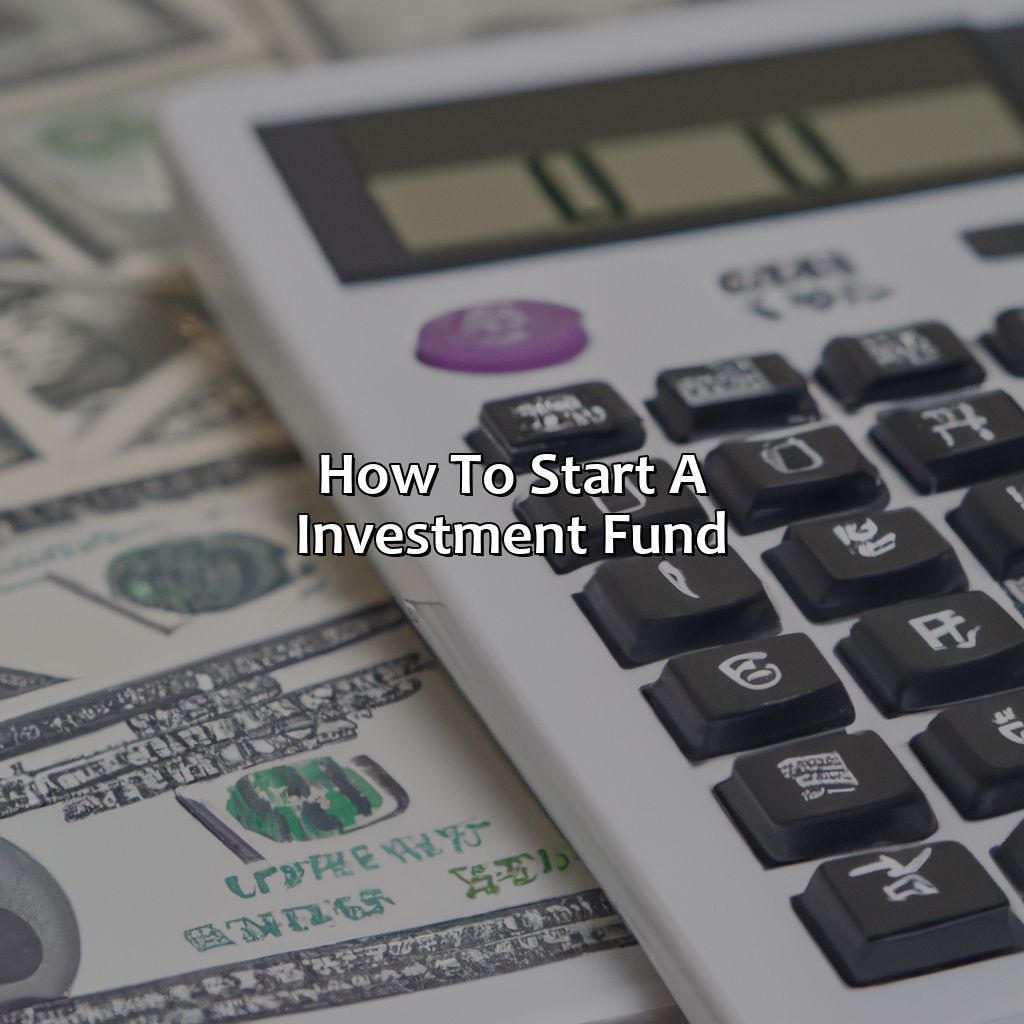How To Start A Investment Fund?
Key Takeaways:
- There are various types of investment funds, including mutual funds, exchange-traded funds (ETFs), and hedge funds, each with its own unique characteristics, fees, and risks.
- Before starting an investment fund, it is important to determine the fund’s objective, identify the target investors, and comply with regulations by hiring a fund manager or managing the fund yourself and registering it properly.
- To ensure success of an investment fund, it is crucial to conduct thorough research and analysis to identify potential investment opportunities, execute trades and manage the fund’s portfolio accordingly, and regularly monitor the fund’s performance to make necessary adjustments.
Are you looking to start your own investment fund? Do you want to make money by investing in stocks, shares and bonds? Read this article to learn how to start a successful investment fund. You will discover the essential knowledge and resources necessary to make sound investments.
Understanding Investment Funds
Investment Funds: A Professional Understanding
Investment funds are financial products that pool money from multiple investors to invest in different securities, such as stocks or bonds. These funds are managed by professional fund managers who aim to generate returns for the investors. As an investor, it is important to understand the different types of investment funds available in the market, such as mutual funds, exchange-traded funds (ETFs), and hedge funds.
Mutual funds are the most common type of investment funds, which are regulated and offer a diversified portfolio of stocks and bonds. ETFs are similar to mutual funds, but they trade like stocks on an exchange. Hedge funds are alternative investment funds that are not regulated and often employ complex strategies. It is important to invest in funds that align with your investment goals, risk tolerance, and time horizon.
When starting an investment fund, it is crucial to have a well-drafted investment strategy, which outlines the investment objectives, risk management practices, and asset allocation strategies. It is also important to have a strong team with diverse skill sets, including portfolio managers, analysts, and operations staff. Proper due diligence is necessary to select the right service providers, such as custodians and audit firms.
In addition, it is important to comply with regulatory requirements and obtain necessary licenses from relevant authorities. Fund managers should also develop a robust compliance framework to ensure adherence to regulations and avoid legal and reputational risks. Overall, understanding investment funds is essential for making informed investment decisions and managing investment funds professionally.

Image credits: retiregenz.com by James Duncun
Types of Investment Funds
Gain insight into the ‘Types of Investment Funds’ by understanding the good & bad of each. Mutual funds, ETFs & hedge funds all have distinct features. Let’s dive in & look closer at the characteristics of each investment funds category.

Image credits: retiregenz.com by Harry Washington
Mutual Funds
Investment funds where investors pool their money and invest in a selection of assets according to the fund’s objectives, are generally known as Mutual Funds. They are managed by professional fund managers who aim to grow the fund whilst minimizing risk. The value of the fund is based on the combined value of its underlying investments.
Mutual Funds offer a range of benefits, including diversification across multiple securities and targeted investment opportunities for particular sectors or regions. Additionally, they are accessible for smaller investors because of lower minimum investments, making them perfect for portable retirement funds.
Furthermore, Mutual Funds provide selection criteria such as investment horizon and risk tolerance to highlight expected performance metrics with regards to your investment plan. This data allows you to match your general preferences with a portfolio strategy that meets your unique needs.
To start investing in Mutual Funds it is recommended to research different types of funds before deciding which one is best for you. Another good option is seeking advice from financial consultants who can help you pick out those mutual funds that align with your financial plan as well as your personal goals.
Investing in ETFs is like eating at a buffet – you get to pick and choose from a variety of options without having to commit to just one.
Exchange-Traded Funds (ETFs)
ETFs are a type of investment fund that trades on stock exchanges, providing investors with diversified exposure to various industries and asset classes. ETFs are low-cost, efficient, and can be traded throughout the day. They track underlying indexes, commodities, or bonds and offer a range of investment opportunities. By buying an ETF, an investor indirectly owns a basket of assets representing the index’s composition it tracks.
ETFs have several advantages over traditional mutual funds or individual stocks. Compared to mutual funds, ETFs trade like stocks on exchanges throughout the day, making it easy for investors to buy and sell their shares at any time during market hours. Also, unlike mutual funds, ETFs usually have lower expense ratios since they do not require as much management style.
Another significant advantage of investing in ETFs is their diversification benefits. With one purchase, investors obtain exposure to a portfolio of stocks or bonds covering different regions or sectors across the world.
Investors must pay attention to various factors before investing in an ETF; understanding underlying securities’ liquidity risk alone can help mitigate potential risks due to market fluctuations.
A portfolio manager seeking cost savings used the simple strategy of buying an S&P 500 index fund tracking stock market performance through an ETF structure instead of hiring analysts or paying for frequent buyer-seller transactions. This simple decision helped him outperform most active managers in the US stock Funds category in less than three years – proving how effectively utilizing ETFs could help boost returns while keeping costs down.
Better start practicing your poker face if you want to invest in hedge funds – it’s not just the funds that are high-risk, but also the personalities behind them.
Hedge Funds
Hedge funds are investment pools that employ different strategies than traditional funds to earn outsized returns. They typically cater to high net worth individuals and institutional investors with a higher risk tolerance.
These investment funds operate with a greater degree of freedom and flexibility than other funds. Hedge fund managers aim to generate profits in all market conditions by using derivatives, leverage, short-selling, and other tactics to maximize returns for their clients. It’s essential to note that hedge funds are only available to accredited or sophisticated investors.
One interesting feature of hedge funds is their ability to invest in a broad range of securities such as commodities, real estate, and currencies. In contrast, mutual funds have restrictions on investing outside of the stock market. Hedge funds also have higher minimum investment requirements than conventional investments.
To start a hedge fund, it’s critical to have capital raised from wealthy investors or institutions due to regulatory compliance costs involved with launching one. Investors should ensure they are operating within the bounds of financial requirements imposed by regulators. Additionally, it’s advisable for potential investors in a hedge fund to assess the past performance of the fund manager before committing their money.
In summary, starting a hedge fund can be lucrative but entails significant risks that require careful planning and adherence to regulations. Investors must weigh the benefits against possible downsides when considering investing in these types of volatile investment vehicles.
Starting an investment fund is like being a hairstylist; you need to have a good sense of risk, know how to manage assets, and make sure your clients leave feeling satisfied with their returns.
Starting an Investment Fund
Begin your investment fund with clear aims and a particular audience. Do this by:
- Figuring out the objective of the fund.
- Identifying who the target investors are.
- Choosing whether to employ a manager or manage the fund yourself.
- Registering the fund and abiding by regulations.
- Launching and marketing to potential investors.

Image credits: retiregenz.com by James Jones
Determine the fund’s objective
When launching an investment fund, determining its purpose and aims is crucial. This involves outlining key objectives and strategies around which the fund will operate and make investments. The fund’s objective needs to be clearly defined, transparent, and realistic. This ensures that the investors’ interests align with those of the investment manager and that there is an understanding of what the investor should expect from their investments.
Identifying the fund’s objective entails selecting specific types of investments, such as commodities or real estate securities, and strategizing how returns will be generated based on these choices. It also means deciding whether to focus on long-term growth or short-term profitability. The overall structure of the fund may also depend on whether it is exempt from regulation by organizations like the SEC.
Unique details such as identifying which key performance indicators (KPIs) will be used to track the success of investment plans need consideration. These KPIs can be chosen to reflect on various aspects of performance such as asset quality or liquidity ratios depending on investor interest.
It’s important to note selecting a clear type of objective while keeping flexibility in mind allows for future adjustments without causing significant alterations in processes established by previous objectives.
To create a well-constructed fund strategy choose compatible securities for investors and put forth expected risks connected financially involved assets while also adjusting investments efficiently based on current market situations, thus resulting in satisfying returns.
Finding the right investors for your investment fund is like searching for a needle in a haystack, but with a little luck and a lot of convincing, you just might strike gold.
Identify the target investors
As you start your investment fund, it is important to identify the specific group of potential investors that align with your investment strategy.
Consider crafting a clear and concise investor profile that outlines key demographic details such as age, income and investment goals. Research industry trends to inform the creation of an investor persona while also tapping into networks to build a database of interested investors.
Moreover, attend sector-specific events and conferences in search of investors. Identify if they are accredited or non-accredited according to SEC guidelines.
Pro Tip: A well-crafted marketing strategy that aligns with your target investor base can help attract suitable capital.
Deciding to hire a fund manager or manage the fund yourself is like choosing between a chauffeur and learning how to drive – either way, someone’s gonna get a wild ride.
Hire a fund manager or manage the fund yourself
When starting an investment fund, deciding whether to hire a fund manager or handle the management yourself is crucial. This decision determines how your funds will be managed and your overall success rate. A fund manager offers professional expertise, diversification opportunities, and can help navigate market fluctuations. However, managing the fund yourself provides autonomy and cost savings, but requires a deep understanding of the investment landscape.
Hiring a fund manager means collaborating with professionals who have in-depth knowledge of market trends and investing strategies. Fund managers offer a diverse set of skills that can potentially increase returns on investments while mitigating risks associated with market volatility. Management fees are relatively higher when hiring a professional compared to handling the management responsibilities personally.
On the other hand, managing the fund independently may save costs incurred from hiring a professional manager. Self-management also gives you complete control over investment decisions and strategic direction without any external influence. This approach requires a deep understanding of market trends and investing strategies and should only be undertaken by those with experience in financial markets.
Ultimately, making this decision depends on several factors such as personal experience in finance, amount of capital available to invest, risk tolerance, and control required over investment decisions. Regardless of which option you choose it’s always important to stay informed about your portfolio’s performance track record through tracking spreadsheets or software tools like Excel or Google Sheets to make informed investment decisions moving forward.
Registering your investment fund may sound daunting, but it’s nothing a lawyer, a strong coffee, and a bribed government official can’t handle.
Register the fund and comply with regulations
To achieve legal status for your investment fund, you must comply with registration and regulatory requirements. Here’s how:
- Choose an appropriate legal structure
- Register for a Securities and Exchange Commission (SEC) filing
- Develop bylaws or operating agreements that align with state and federal law requirements
- Create internal compliance policies and procedures to manage conflicts of interest, insider trading and other risks
- Find trustworthy investment professionals to help you navigate this process.
When complying with regulations, it’s important to thoroughly research applicable state and federal laws, regulatory bodies – like the SEC – and report requirements. You may want to involve a lawyer or consultant familiar with investment funds.
Pro Tip: It is vital to seek guidance from expert professionals who can assist in ensuring full adherence to regulatory authorities’ complex financial guidelines. Get your pitch ready and your poker face on, it’s time to persuade investors to give your fund a shot.
Launch the fund and market it to potential investors
Once you have established your investment fund, the next step is to create a buzz around it and attract potential investors. Building a strong brand image and marketing strategy can go a long way in making your fund more successful.
Here is a 6-step guide on how to effectively launch and market your investment fund:
- Develop a unique value proposition that sets you apart from your competitors.
- Identify your target audience and tailor your marketing efforts towards them.
- Create a comprehensive marketing plan that includes branding, advertising, PR activities, and investor outreach programs.
- Engage with potential investors through events, social media, email campaigns, and other networking opportunities.
- Provide clear information about the fund’s performance, risks involved, investment strategies and how investors will benefit from investing with you.
- Maintain an active presence in the industry by attending conferences, participating in industry discussions, publishing thought leadership articles and other initiatives.
Remember that each investor has their own specific needs and concerns. Make sure you listen to them closely to understand what they are looking for in an investment opportunity before tailoring your messaging.
It’s essential to note that staying compliant while launching an investment fund is critical. Ensure all legal documentation is properly filed with the relevant authorities.
To build trust with potential investors, team up with reputable custodians to manage assets. Operating under complete transparency can help establish credibility with investors.
In summary, launching and marketing an investment fund requires thorough planning of various strategies targeted at attracting potential investors while promoting transparency. Managing an investment fund is like owning a sports team – you can make all the right moves, but sometimes you still end up losing.
Managing an Investment Fund
For a successful investment fund, research is vital. Find potential investments and execute trades. Manage the portfolio well. Monitor the fund’s performance and adjust as needed for profitability.

Image credits: retiregenz.com by Yuval Arnold
Conduct research and analysis to identify potential investment opportunities
To source relevant investment opportunities, meticulous research and analysis play a vital role. Utilizing the power of data-driven approaches such as Machine Learning, Artificial Intelligence, and Big Data Analytics can help identify potential investments. Extensive sector-specific analyses could enable an investor to make informed decisions that involve niche knowledge of local or global markets. In-depth knowledge of financial markets and strong networking among industry leaders provide actionable insights into identifying undervalued assets with high latent return probabilities.
Comprehensively researching unique market opportunities and analyzing those areas that have shown remarkable growth potential enables an investor to build a robust portfolio. Such analysis may include trends in emerging technologies, promising business segments experiencing positive shifts in consumer behaviour, or favorable regulatory changes on company performance. Additionally, news events are critical sources of information that can impact investment-related decisions.
Pro Tip: Ensure you have well-established criteria for evaluating potential investments that would lead you to your strategic objectives. Proper strategies based on predictive analysis ensure effective decision-making processes and remain aligned with the fund’s goals. Managing an investment fund is like playing chess, but instead of pieces, you use money and instead of winning, you aim to not lose too much.
Execute trades and manage the fund’s portfolio
Managing an Investment Fund requires executing trades and managing the portfolio effectively. This is crucial for generating returns and sustaining investor confidence.
Here’s a 3-step guide to effectively ‘Execute trades and manage the fund’s portfolio’:
- Develop an investment strategy based on market trends, investor requirements and fund objectives.
- Monitor investments regularly through data analysis, financial modeling, risk management and legal compliance.
- Review the fund’s performance periodically and report findings to investors to maintain transparency and trust.
It’s vital to note that selecting investments is not only about identifying promising opportunities but also about weighing risk against reward. Ensure that you have a well-diversified portfolio consisting of various asset classes that offer unique benefits.
Finally, a popular historical example of poor execution in managing an investment fund was Long-Term Capital Management (LTCM). The firm had employed expert investors but suffered from overexposure to risky trades, leading to significant losses in 1998. LTCM serves as a reminder of the importance of risk management in executing trades and managing portfolios effectively.
You know it’s a bad day for your investment fund when the only thing that’s performing well is the elevator music.
Monitor the fund’s performance and make adjustments as necessary
To optimize returns, it’s essential to track and adjust the Investment Fund’s performance. Keeping an eye on the fund’s metrics is critical to sustaining success and ensuring long-term investor confidence.
Here are four steps to Monitor the investment fund’s performance effectively and make adjustments as necessary:
- First, establish clear benchmarks and goals aligned with investors’ objectives.
- Second, evaluate the fund’s holdings regularly to ensure they’re in line with the benchmarks and goals set.
- Third, review the market environment for potential risks that could impact fund performance and adjust accordingly.
- Lastly, maintain transparent communication channels with investors about updates in order book or trades in order book for tangible evidence of your progress, ensuring their comfort while investing.
It’s crucial to record each of these steps formally while discussing changes during investment meetings without causing a panic that can lead to an inadvertent cascade cycle.
For more effective management, integrate data analytics software alongside graph for tracking trends over time. This will help determine whether current trends fit within initial benchmarks or whether adjustments need to be made.
Some Facts About How To Start An Investment Fund:
Starting an investment fund requires a significant amount of capital. (Source: Investopedia)
The first step in starting an investment fund is to determine the fund’s investment strategy. (Source: The Balance)
Investment funds are highly regulated institutions and must comply with SEC regulations. (Source: Forbes)
Investment funds can be either actively or passively managed. (Source: Investopedia)
To start an investment fund, it is necessary to have experienced investment professionals on the team. (Source: Entrepreneur)
FAQs about How To Start A Investment Fund?
How do I start an investment fund?
Starting an investment fund requires extensive planning, research, and legal expertise. Here are the general steps:
- Identify your investment strategy and target market
- Develop a business plan and financial projections
- Choose a legal structure and register with regulatory authorities
- Hire a team of professionals, including a lawyer, accountant, and administrator
- Raise capital from investors
- Launch and manage the fund
 Checkout this IRS Loophole
Checkout this IRS Loophole 
